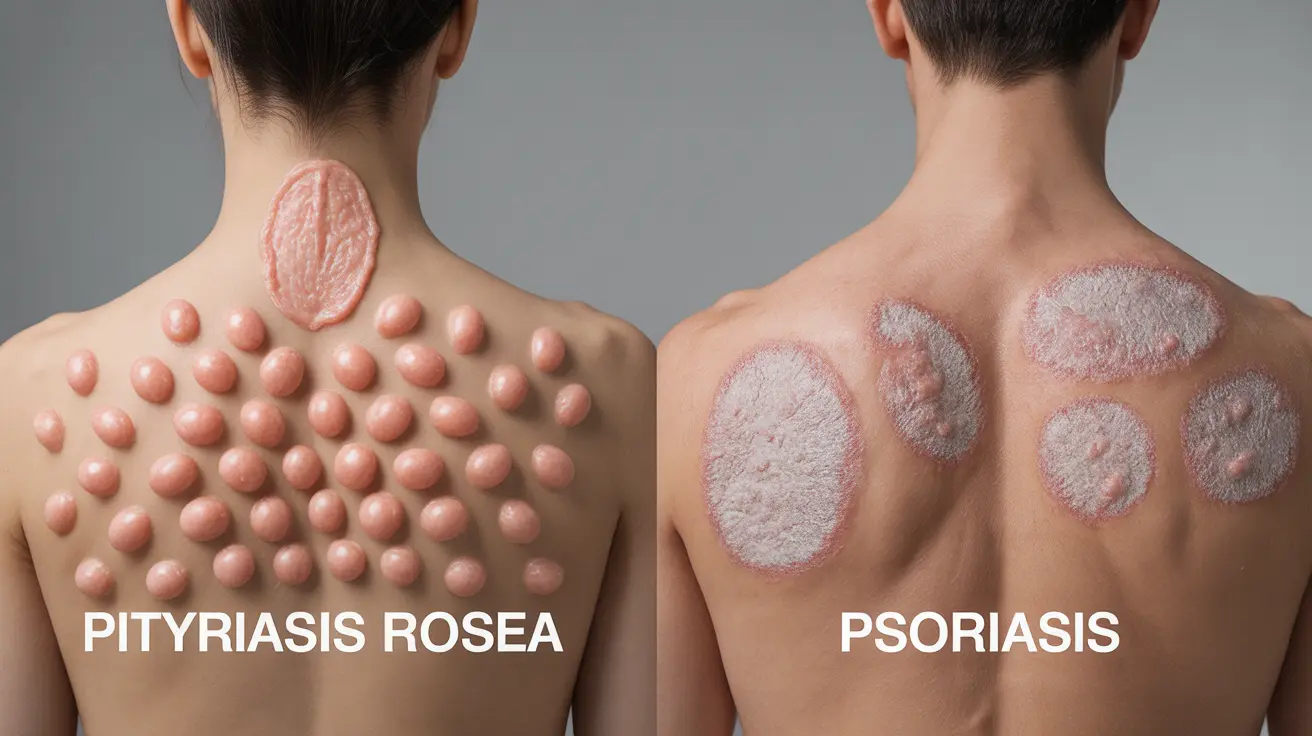When skin conditions appear, getting the right diagnosis is crucial for proper treatment. Two conditions that can sometimes look similar but require different approaches are pityriasis rosea and psoriasis. Understanding their distinct characteristics can help you better communicate with your healthcare provider and manage your symptoms effectively.
This comprehensive guide explores the key differences between these two skin conditions, from their appearance and duration to treatment options and long-term impacts. Whether you're experiencing symptoms or simply seeking information, we'll help you understand these distinct skin conditions.
Distinguishing Features and Appearance
While both conditions affect the skin, they present with notably different characteristics:
Pityriasis Rosea Characteristics
- Herald patch: A single, larger pink or red patch typically appears first
- Smaller oval patches develop in a "Christmas tree" pattern on the torso
- Patches are salmon-colored with a slight scale
- Primarily affects the trunk, less common on extremities
- Minimal itching in most cases
Psoriasis Characteristics
- Well-defined, thick, red plaques with silvery-white scales
- Symmetrical distribution on body
- Common on elbows, knees, scalp, and lower back
- Often accompanied by intense itching
- Can affect any area of the body
Duration and Course of Disease
These conditions follow very different patterns in terms of their duration and progression:
Pityriasis Rosea Timeline
- Typically resolves on its own within 6-8 weeks
- Usually occurs only once in a lifetime
- Follows a predictable pattern of development and clearing
- Rarely leaves lasting marks on the skin
Psoriasis Timeline
- Chronic condition with long-term manifestations
- Cycles of flare-ups and remissions
- Can persist throughout life
- May require ongoing management
Diagnosis and Medical Assessment
Healthcare providers use different approaches to diagnose these conditions:
Diagnosing Pityriasis Rosea
- Visual examination of the characteristic herald patch
- Assessment of the distribution pattern
- Usually no biopsy needed
- Patient history of recent symptoms
Diagnosing Psoriasis
- Clinical examination of plaques
- May require skin biopsy for confirmation
- Family history assessment
- Evaluation of joint symptoms
- Nail changes examination
Treatment Approaches
The management strategies for these conditions differ significantly:
Pityriasis Rosea Treatment
- Often requires no treatment beyond symptom management
- Over-the-counter antihistamines for itching
- Moisturizers to soothe skin
- UV light therapy in severe cases
Psoriasis Treatment
- Topical corticosteroids
- Systemic medications for severe cases
- Biologics for moderate to severe psoriasis
- Phototherapy
- Regular moisturizing
- Lifestyle modifications
Frequently Asked Questions
What are the key differences between pityriasis rosea and psoriasis in terms of symptoms and appearance?
Pityriasis rosea typically begins with a herald patch followed by smaller patches in a Christmas tree pattern, while psoriasis presents as thick, red plaques with silvery scales. Pityriasis rosea mainly affects the trunk, while psoriasis can appear anywhere on the body.
How long does pityriasis rosea typically last compared to chronic psoriasis?
Pityriasis rosea is self-limiting and typically resolves within 6-8 weeks, while psoriasis is a chronic condition that requires long-term management and can have periods of remission and flare-ups throughout life.
Can pityriasis rosea be mistaken for psoriasis, and how is each diagnosed?
Yes, these conditions can be mistaken for each other. Diagnosis of pityriasis rosea typically relies on visual examination and the presence of a herald patch, while psoriasis may require a skin biopsy and more extensive evaluation of symptoms.
What are common treatment options for managing psoriasis versus pityriasis rosea?
Pityriasis rosea often needs minimal treatment beyond symptom management, while psoriasis typically requires ongoing treatment with topical medications, systemic drugs, or biologics, depending on severity.
Does psoriasis affect the joints and nails, unlike pityriasis rosea?
Yes, psoriasis can affect both joints (psoriatic arthritis) and nails, while pityriasis rosea is limited to the skin and does not impact joints or nails.




